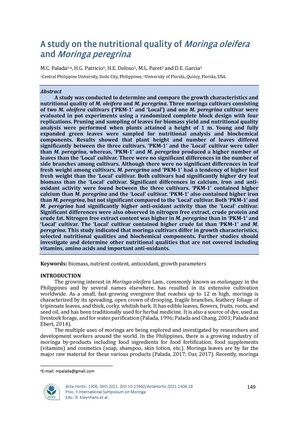Biomass yield of Moringa oleifera as influenced by plant density and harvest frequency

Request
Request a full text copyPage views
716Petsa
2017-05-09Magbahagi
Metadata
Ipakita ang buong tala ng item
Abstract
This study was conducted to determine the leaf biomass of moringa as influenced by plant density and frequency of pruning. Moringa plants were grown at four plant spacings and densities: a) 1×1 m (10,000 plants ha-1 - pph); b) 1×0.5 m (20,000 pph); c) 0.9×0.37 m (30,000 pph) and d) 0.5×0.5 m (40,000 pph), and harvested at three frequencies: 4, 6, and 8 weeks after first pruning for all treatments. The field trial was established and evaluated in a factorial randomized block design with three replications. Moringa seeds of cultivar 'PKM-1' were directly sown in various plots on December 12, 2013. Furrow and sprinkler irrigation were applied once per week to maintain optimum soil moisture for germination and seedling growth. Triple 14 fertilizer was applied at the rate of one tablespoon per plant three weeks after emergence. Seed germination was recorded 10 days after sowing and plant height was measured on a periodic basis. Initial pruning for all treatments was performed to a height of 1 m when plants reached 2 m at 116 days after sowing. Thereafter, harvesting frequencies were followed according to treatments. Results on leaf biomass indicated no increasing trend in leaf fresh biomass with increasing plant density except at 8-week harvest frequency. Highest fresh biomass of 30 t ha-1 was obtained from 40,000 pph harvested at 8-week interval. The lowest fresh leaf biomass was obtained at 10,000 pph. Data on fresh leaf biomass from plants harvested at 4- and 6-week interval at high density (40,000 pph) suggest that these treatments are optimum when there is a monthly demand for fresh raw materials for leaf processing into moringa by-product.
Paglalarawan
Conference paper
Mungkahing Sipi
Patricio, H. G., Palada, M. C., Deloso, H. E., & Garcia, D. E. (2017). Biomass yield of Moringa oleifera as influenced by plant density and harvest frequency. In Ebert, A.W. & Palada, M.C. (Eds.), I International Symposium on Moringa 1158 (pp. 97-103). International Society for Horticultural Science. https://doi.org/10.17660/ActaHortic.2017.1158.12
Uri
Conference paperISSN
0567-7572; 2406-6168ISBN
978-94-62611-55-9Mga Paksa
Mga keyword
Serye
ISHS Acta Horticulturae;1158Collections
Mga parehong item
Ipinapakita ang mga item na nauugnay sa pamagat, may-akda, tagalikha at paksa.
-
A study on the nutritional quality of Moringa oleifera and Moringa peregrina
Palada, Manuel C.; Patricio, Hope G.; Deloso, Homer E.; Paret, Mathews; Garcia, D. E. (International Society for Horticultural Science, 2021-04-15)A study was conducted to determine and compare the growth characteristics and nutritional quality of <em>M. oleifera</em> and <em>M. peregrina</em>. Three moringa cultivars consisting of two <em>M. oleifera</em> cultivars ... -
Evaluation of the efficacy of essential oil from moringa leaves (Moringa oleifera) against Staphylococcus epidermidis
Mañosa, Rhegil Joseph B. (2024-04)Staphylococcus epidermidis is a coagulase-negative and gram-positive bacterium that can cause arthritis, tendinitis, tenosynovitis, osteomyelitis and omphalitis in poultry animals. It is the most common cause of nosocomial ... -
Brooding performance of Philippine native chicken supplemented with moringa (Moringa oleifera Lam.) and hot red pepper (Capsicum annum L.) as mineral and vitamin premix
Servidad, Layka A. (2019-04)The study was conducted from February 21 to March 14, 2018 at CPU-CARES Research and Development Learning Center, Jaro, Iloilo City. The study was conducted to determine the brooding performance of Philippine native chicken ...





